Preparation and Performance Study of Deep Shale Sealing Agent Based on Montmorillonite Modification(Part 2)
2.4 Contact Angle Test
After compressing montmorillonite into tablets, the water droplet method was used to measure its water wetting contact angle using a fully automatic contact angle measuring instrument (SDC-350 contact angle measuring instrument), as shown in Figure 5. The water wetting contact angle of the original montmorillonite sample is 33.04°. After modification, the water wetting contact angle of N-MMT increases to 95.00°, indicating a decrease in surface polarity and a significant increase in hydrophobicity, which is more conducive to its dispersion and application in oil-based drilling fluids.
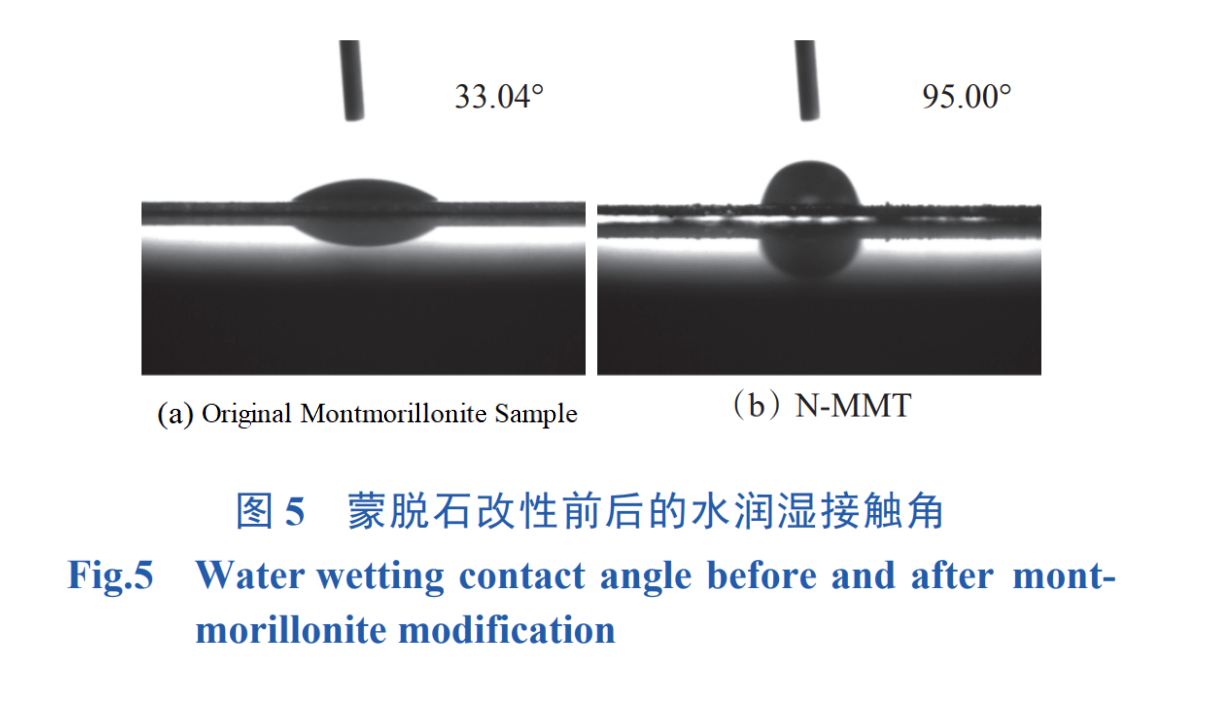
2.5 Microscopic Morphology
The microstructure of montmorillonite before and after modification was observed using a desktop scanning electron microscope (Phenmo pro X), as shown in Figure 6. The size of untreated montmorillonite particles depends on the number of stacking layers and the size of the single-layer surface area. The maximum particle size is greater than 3 μm, which is consistent with the particle size analysis results, indicating its single-layer stacking structure. The particle size of the nanosheets obtained by montmorillonite exfoliation treatment is significantly smaller than the initial state, basically at the nanoscale, providing a basis for the subsequent preparation of nano sealing agents. Observing the microstructure of modified montmorillonite nanosheets, it was found that their size increased compared to montmorillonite nanosheets, with montmorillonite nanosheets as the matrix inside and functional molecules growing on the surface, consistent with the particle size analysis results.
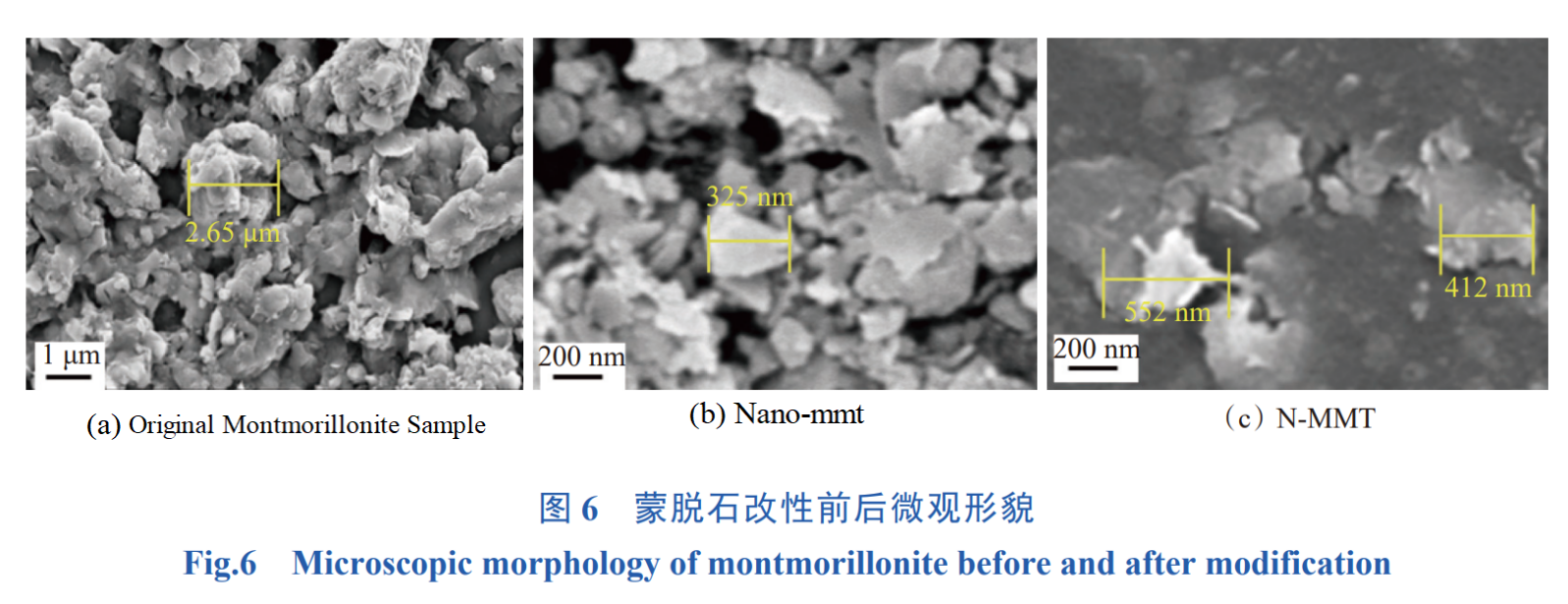
2.6 Thermogravimetric Analysis
The thermal stability of montmorillonite before and after modification was tested using a synchronous thermogravimetric analyzer (STA449F3), and the results are shown in Figure 7. The thermal weight loss of the original montmorillonite sample below 200℃ is 7.71%, mainly due to the adsorption of water on the surface of montmorillonite. There is an endothermic peak at 477℃, mainly caused by the thermal decomposition of bound water in the crystal structure of montmorillonite and surface hydroxyl groups. After functional modification, the first stage is when the temperature is below 200℃, and the thermal weight loss of nano montmorillonite is 3.01%, mainly attributed to its surface adsorption of water. It can be seen that the water absorption of modified nano montmorillonite is significantly reduced. In the second stage, as the temperature further increases to around 300℃, the quality begins to significantly decrease, with a quality loss of 24.99%, mainly attributed to the fracture and decomposition of amide and ester groups in the grafted chain; The final stage of quality loss is at a temperature of 450-600℃, with a quality loss of 16.94%, mainly attributed to the decomposition of the alkyl main chain. The above results indicate that the thermal stability of modified nano montmorillonite is good under conditions of temperature not exceeding 300℃.

3. Performance Evaluation of Nano Sealing Agents
3.1 Core Self Suction Test
There are a large number of micro and nano scale cracks and pores on the surface of shale rock cores, which can induce capillary phenomenon and cause natural seepage, resulting in wellbore instability. N-MMT, nano SiO2, and organic soil were prepared into 3% white oil solutions, and the on-site rock cores from the Ning209 well area of the Longmaxi Formation were soaked in the white oil solution for self suction testing. The results are shown in Figure 8. After 3 hours of natural infiltration, the shale core soaked in pure white oil absorbed 0.09g of white oil. After several particle interactions, the oil absorption of the shale core decreased; The oil absorption of the core soaked in 3% nano sealing agent N-MMT white oil for 3 hours was 0.03g, and the natural permeability decreased by 66.7%, indicating that the nano sealing agent N-MMT can seal shale pores and prevent the core from self suction. he oil absorption of the core soaked in white oil containing 3% nano SiO2 for 3 hours is 0.045g, indicating that the sealing effect of nano SiO2 is not as good as that of N-MMT; Organic soil can also reduce the self absorption of rock cores, but its effect is far inferior to the two types of nanoparticles. It is speculated that the decrease in oil absorption is due to the change in solution viscosity caused by organic soil. It can be seen from this that the prepared nano sealing agent can seal micro cracks and inhibit the damage of drilling fluid filtrate to the pore throat structure of the formation.
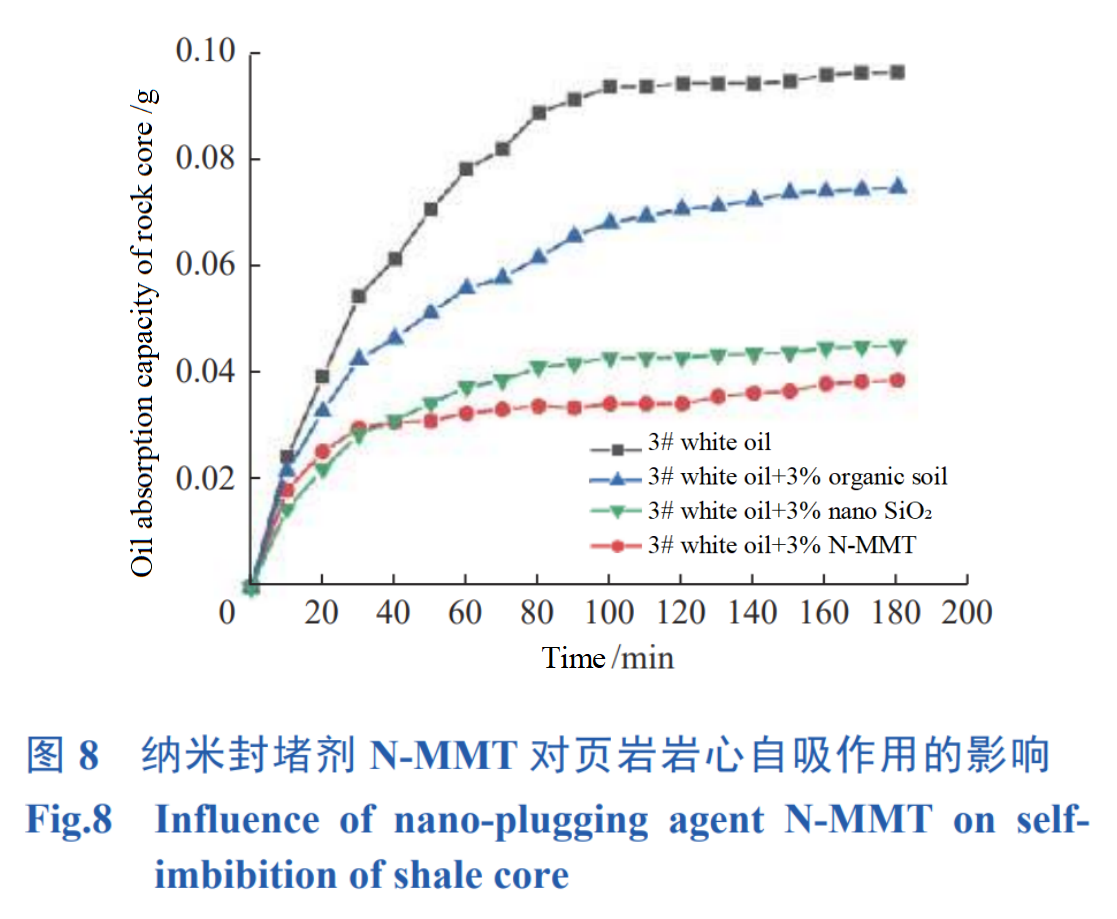
Scanning electron microscopy was used to observe the changes in the surface microstructure of shale cores (see Figure 9). Shale has developed a large number of micropores and microcracks. After treatment with the nano sealing agent N-MMT, the cracks and pores are filled with the sealing agent. The surface of shale is relatively flat, dense, and smooth. The prepared nano montmorillonite can be compressed into specific micro and nano pores of shale, filling the internal pores and forming a sealing film with a certain structural strength, thereby achieving protection of the internal structure of shale.
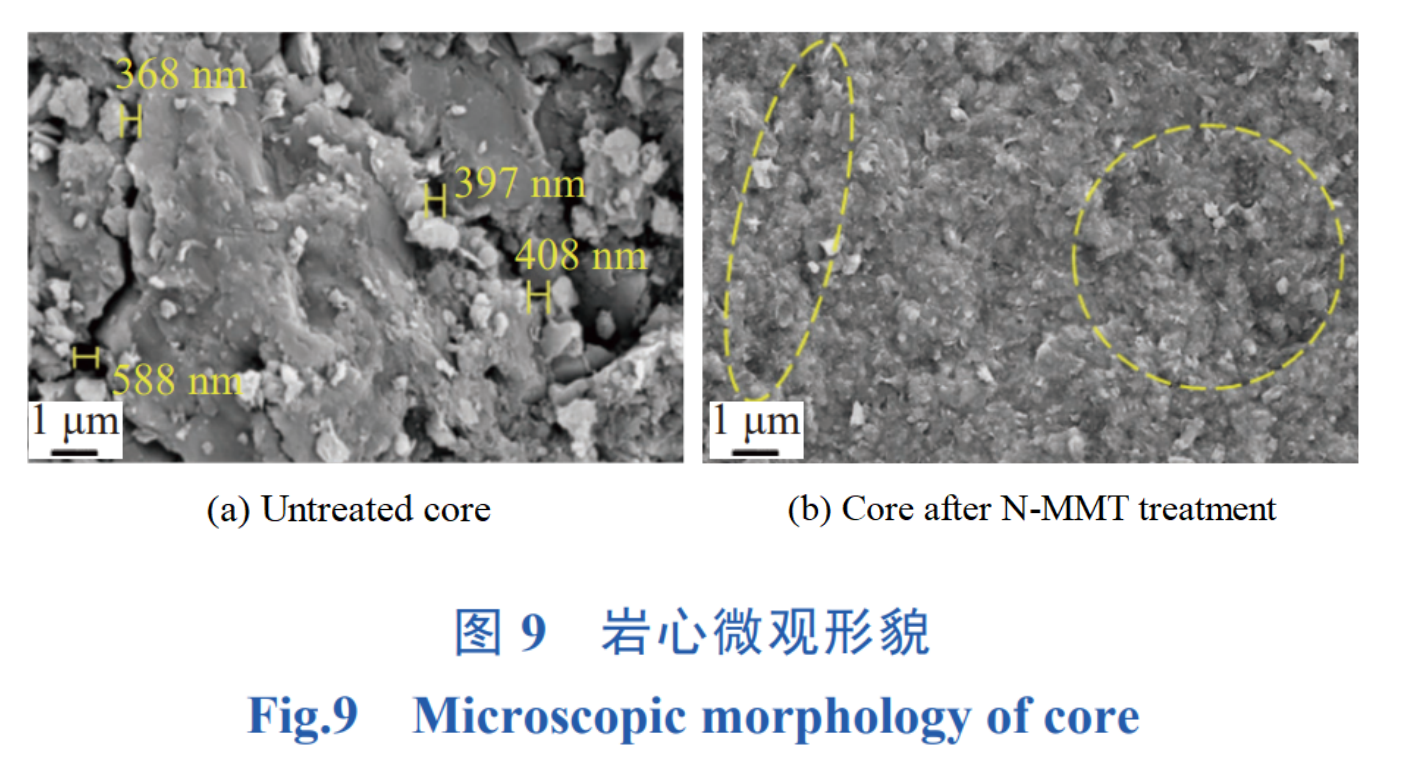
3.2 Sealing Test of Microporous Filter Membrane
Nano sealing agent N-MMT was added to oil-based drilling fluid for shale gas drilling. After rolling aging at a temperature of 180℃ for 16 hours, the filtration loss at high temperature and high pressure (180℃/3.5MPa) was tested using a 220nm pore size filter membrane to evaluate the sealing ability of nano sealing agent N-MMT on micro and nano pores in oil-based drilling fluid. The experimental results are shown in Figure 10. Drilling fluid formula: 3# white oil+CaCl2 aqueous solution (mass fraction 25.0%)+4.0% main emulsifier+1.0% auxiliary emulsifier+1.5% wetting agent+1.0% organic soil+nano sealing agent N-MMT. The density of barite is increased to 1.80kg/L, and the volume ratio of white oil to 25.0% CaCl2 aqueous solution is 7:3.
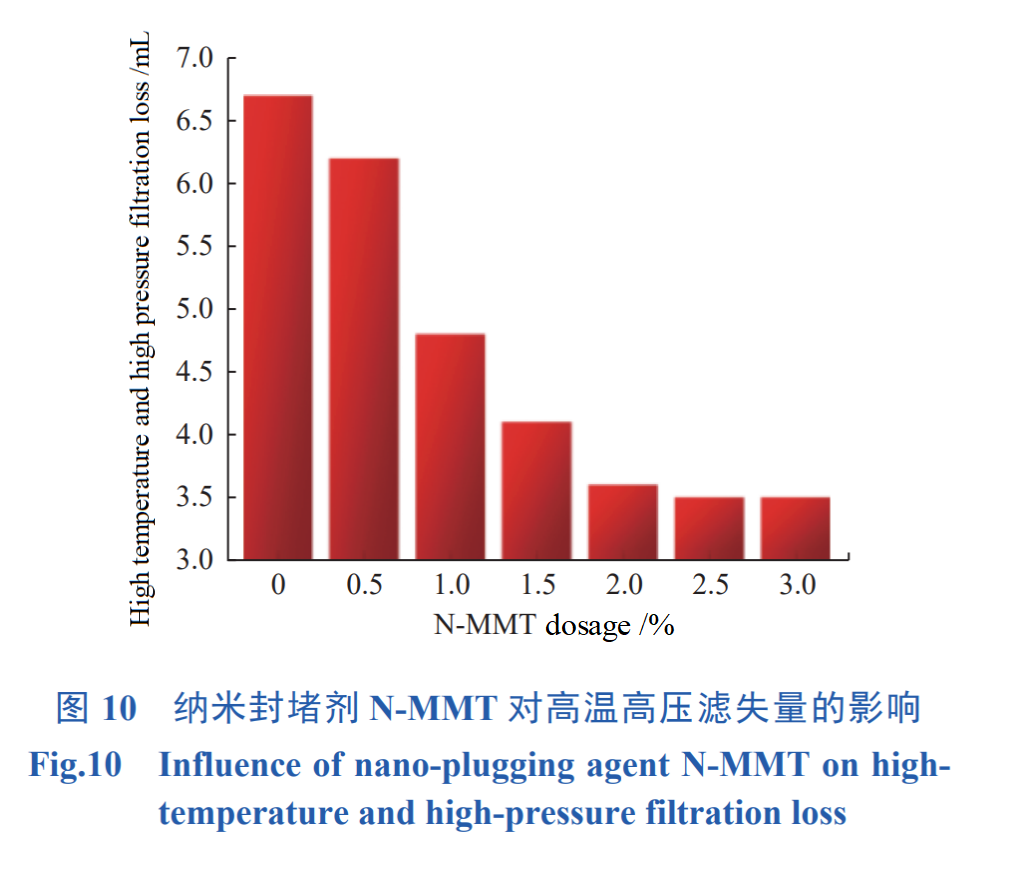
From Figure 10, it can be seen that the filtration loss of the drilling fluid system without N-MMT is 6.8mL. As the amount of N-MMT in the system increases, the high-temperature and high-pressure filtration loss significantly decreases; When the N-MMT dosage is 2.5%, the filtration loss of the system decreases by 47%; When the dosage increased to 3.0%, the filtration loss no longer changed significantly. It can be seen that the nano blocking agent N-MMT has a significant effect on reducing filtration loss, and the optimal dosage is 2.5%.
3.3 Evaluation of Drilling Fluid Performance
To investigate the rheological and electrical stability changes of oil-based drilling fluid with the addition of plugging agent, the drilling fluid formula is: 3 # white oil+CaCl2 saline solution (mass fraction 25.0%)+4.0% main emulsifier+1.0% auxiliary emulsifier+1.5% wetting agent+1.0% organic soil+2.5% nano plugging agent N-MMT, weighted with barite to a drilling fluid density of 1.80kg/L, with a volume ratio of 7:3 between white oil and 25.0% CaCl2 saline solution. Rolling aging was carried out for 16 hours at temperatures of 180℃ and 200℃, and the rheological data of the drilling fluid was measured at a temperature of 60℃. The results are shown in Table 1. After adding 2.5% nano plugging agent N-MMT, the demulsification voltage of the drilling fluid system after rolling aging at 180℃ and 200℃ increased by 10.7% and 10.2% respectively, and the viscosity slightly increased, indicating that the nano plugging agent has good compatibility with conventional treatment agents, which can not only reduce the high-temperature and high-pressure filtration of the drilling fluid, but also improve the stability of the system lotion, increase viscosity and shear.

4. Conclusion and Suggestions
1). N-MMT, a nano sealing agent modified with montmorillonite, has an average particle size of 526nm, strong hydrophobicity, and is easy to disperse in oil-based drilling fluids. It has good thermal stability below 300℃.
2). The nano sealing agent N-MMT can tightly adsorb on shale microporous fractures to form a sealing film, significantly inhibiting the self suction effect of the rock core. It can achieve tight sealing of nano pores and fractures by nano sheets, reduce high-temperature and high-pressure filtration loss, prevent drilling fluid filtrate from invading the formation, and prevent leakage from occurring.
3). The nano plugging agent N-MMT has good compatibility with the conventional treatment agent of oil-based drilling fluid, which can improve the stability, viscosity and shear of the system lotion to a certain extent. However, this article only preliminarily evaluated the performance of the sealing agent N-MMT through conventional indoor experiments, and further in-depth research is needed to study its sealing mechanism and form an oil-based drilling fluid sealing technology suitable for deep shale drilling.
